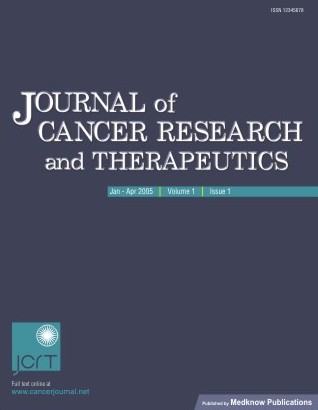
|
Journal of Cancer Research and Therapeutics
Medknow Publications on behalf of the Association of Radiation Oncologists of India (AROI)
ISSN: 0973-1482 EISSN: 1998-4138
Vol. 7, Num. 3, 2011, pp. 391-392
|
Journal of Cancer Research and Therapeutics, Vol. 7, No. 3, July-September, 2011, pp. 391-392
Book Review
Yoga and Cancer
CR Sridhar
Operations Research, Fellow - Royal Statistical Society, President: Nuvis Analytics Pvt. Ltd, India
Correspondence Address: C R Sridhar, Operations Research, Fellow - Royal Statistical Society, President: Nuvis Analytics Pvt. Ltd, India, Sridhar.cr@gmail.com
Code Number: cr11104
Author: Dr. Swami Yogapratap: Exploring Yoga and Cancer Publishers: Yoga Publications Trust, Munger, Bihar, India Publication date: 2009 Author: Dr. Swami Nirmalananda: Yogic Management of Cancer Publishers: Yoga Publications Trust, Munger, Bihar, India Publication date: 2009 This is a combined review of two books on yoga and cancer, since much of the material is common to both. Also, these two books present cancer Management through yogic perspective of a reputed yoga school, the Bihar School of Yoga. Most books on yogic Management of diseases have been written by yoga experts who have very little in-depth understanding of the anatomical and physiological aspects of diseases. Hence, their recommendations for preventing or managing common diseases tend to be suspected in the eyes of professionals as well as patients. The situation is further worsened by half-clad babas making a spectacle of themselves on the television by making wild claims on the effectiveness of asanas and pranayamas on preventing and eliminating chronic diseases in a jiffy. It is a relief to see these two books from the Bihar School of Yoga written by medical professionals who have studied and practiced Yoga. According to yoga, human beings are made of five sheaths (koshas). They are annamaya kosha, pranamaya kosha, manomaya kosha, vijnanamaya kosha and anandamaya kosha. Each of these is responsible for managing specific aspects of a human being. Annamaya kosha is the visible human body; pranamaya kosha manages the life force or prana through the chakras, and so on. All diseases emanate because of an imbalance in these koshas caused either by contact with carcinogens (for eg: cigarette smoke) or an internal disturbance due to a poor stress response. Yoga, through its practices of asana, pranayama, pratyahara, dharana and dhyana brings the balance back in the five Koshas and brings the human back to health. In this process, the human connects to his true self (atman) and becomes complete. Dr. Yogapratap′s book consists of three main sections: the nature and causes of cancer, how yoga practices work and management of cancer with yoga. The first section on the nature and causes is largely from anatomy and physiology as studied by doctors practicing allopathic treatment. The second section is on yogic practices and what they do to the human body and mind. The treatment of the practices covers almost the entire gamut of techniques in asana, pranayama, pratyahara and dharana. The author recognizes that yoga is an adjunct therapy to the conventional allopathic treatment of chemotherapy, radiation and surgery. Nowhere in the book does he make tall claims on yoga′s curative powers on cancer. Swami Nirmalananda′s book consists of two main sections: understanding cancer and learning to cope. The contents of these sections have a lot of commonality with Yogapratap′s book and deals with the same techniques and therapy route. The interesting difference between the two books is the following: Yogapratap′s book starts with the body-mind-spirit triad, whereas Nirmalananda′s book focuses on uniting the human with the atman. A sage described yoga as ′ a set of techniques that brings the idiot face to face with his intelligence′. The problem of connecting the knowledge of cancer and techniques of yoga are not clearly addressed by either book. The readers cannot find an answer to questions like, ′does Sitali Pranayama alter a mutated gene? Ayurveda and yoga suffer from lack of trial-based evidence, and hence confidence. For example, see the following statements. This asana deepens breathing. It can help in removing backache and keep the spine supple and healthy. It tones the ovaries and uterus, and helps in gynecological disorders. It stimulates appetite, alleviates constipation and is beneficial for all abdominal organs, especially the liver and kidneys′. Such statements describing the benefits of Bhujangasana are not useful in either treating cervical cancer or jaundice. The two books are extremely useful to the cancer specialists to get a yogic perspective. This could be of considerable use to them in managing their patient′s internal life. These books offer a brief overview of cancer and yoga and open an option to manage the disease, for the cancer patients. These are the first efforts of medical professionals bringing yoga for the management of cancer. One can identify the gaps that exist between the current knowledge of cancer and yogic therapy for cancer and further efforts should be made to bridge the gaps. The benefits of yoga are well known, but as a treatment for cancer it is currently not an established or accepted option. Yoga is an intuitive science, if you call it a science. Should the practices be tested using the conventional testing methods using monitored trials? Yes, definitely. However, the crux of the problem that who will fund such large scale expensive trials still remains.
Copyright 2011 - Journal of Cancer Research and Therapeutics
| 